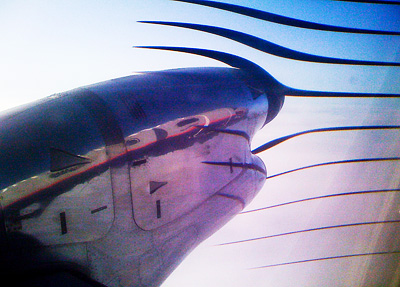
I'm always fiddling with my iPhone camera when I fly. This morning, as I was heading out of San Francisco on a twin-engine turbo prop plane, I was snapping pictures through the window to pass the time. As we rose above the clouds, this shot caught my eye because of the weird phenomenon that appears on the right side of the frame. These ribbon-like lines were visible on the iPhone screen and were recorded when I took the shot. I took two other frames and got the same effect.
My guess is that they were created because of the angle of the lens, through double-pane glass, with the sun at just the right angle. But I don't really know what caused them. Unlike other optical aberrations, these ribbons are so distinct.
The interesting part is that they are pretty in a odd sort of way. If anyone has a theory as to how they were created, please add a comment at the end of this post.
"Turbo Prop Engine with Ribbon Lines" by Derrick Story, captured with an iPhone.
-
Join me on March 28 for "How I Did It" - A Workshop in High-Impact Photography
Technorati Tags: Derrick Story, digital photography, Technology, The Digital Story, iPhone












Wow -- it's like the air is warping. Lovely image.
-Dan
Derrick,
It is the iPhone Shutter. It has been recorded a number of times when people take photos with the iPhone of propeller powered aircraft with engines running. The electronic nature of the shutter appears to be the cause. I will try to find some additional shots to show the effect and if I can figure out how to post them, I will.
Chris
My guess is that it's the prop. The camera in the iPhone doesn't read out all at once and it doesn't have any kind of shutter (physical or electronic). So, as it's reading data line by line, it's literally capturing different chunks of time as the prop is rapidly rotating.
Maybe. :)
It's a limitation of the CMOS sensor used to record the image. It's not recording the frame all at once, but rather line by line and so any fast moving or rotating thing like props will be in a different spot during the exposure.
Derrick I think there are some interesting things going on here. 1st is the obvious aspect that the propeller blade is only captured in the horizontal position or what it may seem to be with subtle bending variants between the ends of the blades. 2nd the propeller blades seems to get thinner towards the bottom of the image.
These 2 clues tell me that the image may be scanned from the image sensor from either top to bottom or bottom to top. Because of this, the blade appears at each revolution or spin as the sensor progresses down the available light seen through the lens. Since the sensor may be scanning in a direction it can only get the blade in horizontal position and blurs out the vertical position because it is against the grain of capture. Also vertical captures would not align up if that is true. I may make a test of my camera on a animated horizontal line to see if this rings true.
It seems from the comments here to be to do with the sensor/shutter/CMOS stuff.
Is this what others refer to as a rolling shutter?
If so, I'd be interested as to how the prop would show using an HD video camera with CMOS/rolling shutter.
That said - fascinating image :)
Wow. that is awesome.
So this is interesting... the ribbon lines are actually the propeller, right? Wow. You guys are *really* helpful :)
At a guess, this might be due to the 'shutter speed of the camera' equalling the propeller rotation speed.
I agree that it's an artifact caused by the slow speed of the "shutter" system in the iPhone and the fast rotation of the prop. But what is kinda neat is that they look like flow lines of air coming over... not really but the circular movement is making it look so.
People guessing that it is due to reading the sensor line-by-line are right. Here is a simulation video that shows in slow-motion how the image turns out like it does:
http://scalarmotion.wordpress.com/2009/03/15/propeller-image-aliasing/
People guessing that it is due to reading the sensor line-by-line are right. Here is a simulation video that shows in slow-motion how the image turns out like it does:
http://scalarmotion.wordpress.com/2009/03/15/propeller-image-aliasing/
Very cool! I took this photo out of the window of our flight from Denver to Jackson, WY, because I was trying to capture some of the ice and snow that was accumulating on the leading edge of the wing. We were in clouds most of the flight, and when we broke out into some clear air, I decided to take a pic with my iPhone. The Bombadier Q400 is a turboprop with gigantic 6-bladed propellers. When I looked at the first picture I took, I thought that something must have malfunctioned in the camera, so I took another, and here it is - the other looks the same. Some sort of interaction between the CCD scanning process and the prop turning at 1800 (?) rpm.
Sorry - here's a link to the image:
http://www.facebook.com/home.php#/photo.php?pid=30182939&id=1345417723&ref=mf
Thanks for your sharing. There are not much websites outthere have such useful source of informations like this one. Thanks again because it's very hard to find something can compete with.
Yep you got it..cmos scanning instead of 'snapping' ..looks cool for a while..then after having these lines wreck all of my flying photos..becomes annoying! :-)
(highly repeatable)
http://www.facebook.com/photo.php?pid=131737&l=7f83cead11&id=100000024564852